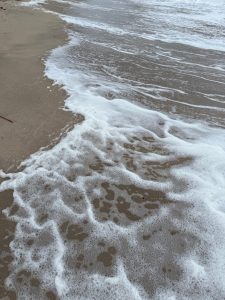When the ocean gets churned up, what is this sea foam?
Posted By RichC on October 22, 2024
 Brenda and I have been working hard to walk the beach while on our annual October vacation to Florida. This year the ocean weather has been windy, a bit rainy … but warm. We’ve found the longer than usual walk challenging as the waves and tide has shrunk the beach and churned the water. We’ve seen sea-foam before, but never really gave it much thought. I sort of remembered that it was associated with pollution run-off that we humans create … but not entirely … some of it is natural.
Brenda and I have been working hard to walk the beach while on our annual October vacation to Florida. This year the ocean weather has been windy, a bit rainy … but warm. We’ve found the longer than usual walk challenging as the waves and tide has shrunk the beach and churned the water. We’ve seen sea-foam before, but never really gave it much thought. I sort of remembered that it was associated with pollution run-off that we humans create … but not entirely … some of it is natural.
Sea water is 96.5 percent water and 2.5 percent salt. That only adds up to 99 percent, so what’s the other 1 percent? A lot of things. According to the National Oceanic and Atmospheric Administration (NOAA), it’s “proteins, fats, dead algae, detergents, and other pollutants,” plus other bits of inorganic and organic material. When these particles get agitated by wind and waves, they froth. You can create the same effect by shaking ocean water vigorously in a bottle.
The sea foam bubbles happen because of molecules called surfactants, which Popular Science explains are “sticky molecules that cling to the surface between water and air.” This sea surface microlayer can come from natural sources, like algae and seaweed, or from human pollution, like fertilizers, detergents and sewage. Ew.
One end of the molecule is hydrophobic – it repels water. The other end is hydrophilic – it attracts water. The easiest shape for these molecules to form is a sphere, with the hydrophobic ends on the inside and the hydrophilic ends pointing outward. Spheres (even if they aren’t perfect) make bubbles. And a lot of bubbles make sea foam!
Comments